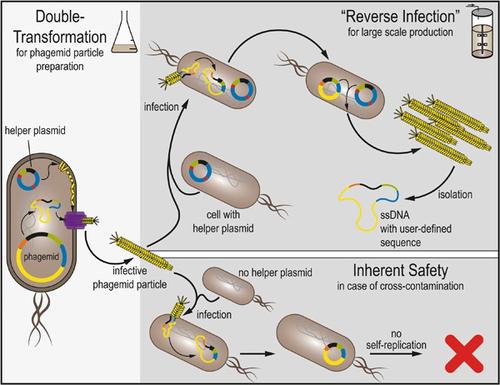当前位置:
X-MOL 学术
›
Biotechnol. Bioeng.
›
论文详情
Our official English website, www.x-mol.net, welcomes your
feedback! (Note: you will need to create a separate account there.)
Phage-free production of artificial ssDNA with Escherichia coli
Biotechnology and Bioengineering ( IF 3.5 ) Pub Date : 2022-07-05 , DOI: 10.1002/bit.28171 Karl L Behler 1 , Maximilian N Honemann 2, 3 , Ana R Silva-Santos 2 , Hendrik Dietz 2, 3 , Dirk Weuster-Botz 1
Biotechnology and Bioengineering ( IF 3.5 ) Pub Date : 2022-07-05 , DOI: 10.1002/bit.28171 Karl L Behler 1 , Maximilian N Honemann 2, 3 , Ana R Silva-Santos 2 , Hendrik Dietz 2, 3 , Dirk Weuster-Botz 1
Affiliation

|
Artificial single-stranded DNA (ssDNA) with user-defined sequences and lengths up to the kilobase range is increasingly needed in mass quantities to realize the potential of emerging technologies such as genome editing and DNA origami. However, currently available biotechnological approaches for mass-producing ssDNA require dedicated, and thus costly, fermentation infrastructure, because of the risk of cross-contaminating manufacturer plants with self-replicating phages. Here we overcome this problem with an efficient, scalable, and cross-contamination-free method for the phage-free biotechnological production of artificial ssDNA with Escherichia coli. Our system utilizes a designed phagemid and an optimized helper plasmid. The phagemid encodes one gene of the M13 phage genome and a freely chosen custom target sequence, while the helper plasmid encodes the other genes of the M13 phage. The phagemid particles produced with this method are not capable of self-replication in the absence of the helper plasmid. This enables cross-contamination-free biotechnological production of ssDNA at any contract manufacturer. Furthermore, we optimized the process parameters to reduce by-products and increased the maximal product concentration up to 83 mg L−1 of ssDNA in a stirred-tank bioreactor, thus realizing up to a 40-fold increase in maximal product concentration over previous scalable phage-free ssDNA production methods.
中文翻译:

用大肠杆菌无噬菌体生产人工 ssDNA
具有用户定义序列和长度可达千碱基范围的人工单链 DNA (ssDNA) 越来越需要大量使用,以实现基因组编辑和 DNA 折纸等新兴技术的潜力。然而,目前可用的大规模生产 ssDNA 的生物技术方法需要专用的发酵基础设施,因此需要昂贵的发酵基础设施,因为存在自我复制噬菌体交叉污染制造植物的风险。在这里,我们通过一种高效、可扩展且无交叉污染的方法克服了这个问题,该方法用于用大肠杆菌进行人工 ssDNA 的无噬菌体生物技术生产. 我们的系统利用设计的噬菌粒和优化的辅助质粒。噬菌粒编码 M13 噬菌体基因组的一个基因和自由选择的定制靶序列,而辅助质粒编码 M13 噬菌体的其他基因。用这种方法产生的噬菌粒颗粒在没有辅助质粒的情况下不能自我复制。这可以在任何合同制造商处实现无交叉污染的 ssDNA 生物技术生产。此外,我们优化了工艺参数以减少副产物,并将搅拌罐生物反应器中 ssDNA 的最大产物浓度提高到 83 mg L -1,从而实现了最大产物浓度比以前的可扩展性提高了 40 倍无噬菌体 ssDNA 生产方法。
更新日期:2022-07-05
中文翻译:

用大肠杆菌无噬菌体生产人工 ssDNA
具有用户定义序列和长度可达千碱基范围的人工单链 DNA (ssDNA) 越来越需要大量使用,以实现基因组编辑和 DNA 折纸等新兴技术的潜力。然而,目前可用的大规模生产 ssDNA 的生物技术方法需要专用的发酵基础设施,因此需要昂贵的发酵基础设施,因为存在自我复制噬菌体交叉污染制造植物的风险。在这里,我们通过一种高效、可扩展且无交叉污染的方法克服了这个问题,该方法用于用大肠杆菌进行人工 ssDNA 的无噬菌体生物技术生产. 我们的系统利用设计的噬菌粒和优化的辅助质粒。噬菌粒编码 M13 噬菌体基因组的一个基因和自由选择的定制靶序列,而辅助质粒编码 M13 噬菌体的其他基因。用这种方法产生的噬菌粒颗粒在没有辅助质粒的情况下不能自我复制。这可以在任何合同制造商处实现无交叉污染的 ssDNA 生物技术生产。此外,我们优化了工艺参数以减少副产物,并将搅拌罐生物反应器中 ssDNA 的最大产物浓度提高到 83 mg L -1,从而实现了最大产物浓度比以前的可扩展性提高了 40 倍无噬菌体 ssDNA 生产方法。









































 京公网安备 11010802027423号
京公网安备 11010802027423号